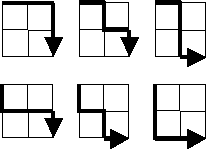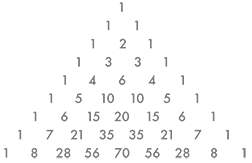
Project Euler 15 Solution & HackerRank version
Lattice paths
by {BetaProjects} | MAY 17, 2009 | Project Euler & HackerRankProject Euler 15 Statement
Starting at the top left corner of a 2×2 grid, there are 6 routes (without backtracking) to the bottom right corner.

How many routes are there through a 20×20 grid?
Solution
 Here’s a similar question with more context.
Here’s a similar question with more context.
"Starting at the top left corner of a grid, how many ways through town are possible using only south or east one–way streets and ending at the bottom right corner of the n×n grid?"
The valid paths for a 2×2 grid shown in the example are the discreet (unique) permutations of {R, R, D, D}. We can list these as: {R, R, D, D}, {R, D, R, D}, {R, D, D, R}, {D, R, R, D}, {D, R, D, R} and {D, D, R, R}. You must have 2 Rs (rights) and 2 Ds (downs), the order not being important, and as long as you start from the top–left corner you will always end at the bottom–right corner.
A 4×4 grid example
To find the number of paths in a 4×4 grid, you’ll have to generate all the discreet permutations of {R, R, R, R, D, D, D, D}, where any combination of 4 Rs and 4 Ds will always be a valid path. If the Rs are first placed randomly in any 4 of the 8 open positions, then they are considered independent. The Ds are considered dependent because they have no choice but to be placed into the remaining slots.
For example, placing the 4 Rs randomly in any of the available 8 positions as {R, _, R, R, _, R, _, _} will dictate where the Ds get placed as {R, D, R, R, D, R, D, D}. You will have 8C4 = 70 valid combinations. This could be interpreted as: how many distinct ways can you shuffle the characters in the string “RRRRDDDD”.
Count the number of routes using the binomial coefficient
The number of contiguous routes for a square grid (n×n) is the central binomial coefficient or the center number in the 2nth row of Pascal’s triangle. The rows start their numbering at 0.

The formula in general for any rectangular grid (n×m) using the notation for the binomial coefficient is:
HackerRank version
HackerRank Project Euler 15 includes rectangular grids in addition to square grids, increases the size to 500×500 and runs 1,000 test cases.
Python Source Code
- from math import factorial as f
- n, m = map(int, input("Enter dimensions (separate by space)?").split())
- print ("Routes through a", n, "x", m, "grid", f(n+m) // f(n) // f(m))
Last Word
Another example assumes an 8 x 8 grid.
“Place a single rook on the top left corner of an empty chess board. Count the number of tours to the bottom right corner, moving only right and down.”
- Reference: The On–Line Encyclopedia of Integer Sequences (OEIS) A000984: Central binomial coefficients: C(2*n,n) = (2*n)!/(n!)^2.
- Changing the condition “contiguous paths which do not pass below the diagonal on an n×n grid” to our problem statement, we would use a Catalan number. It is calculated as: